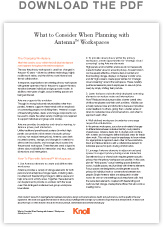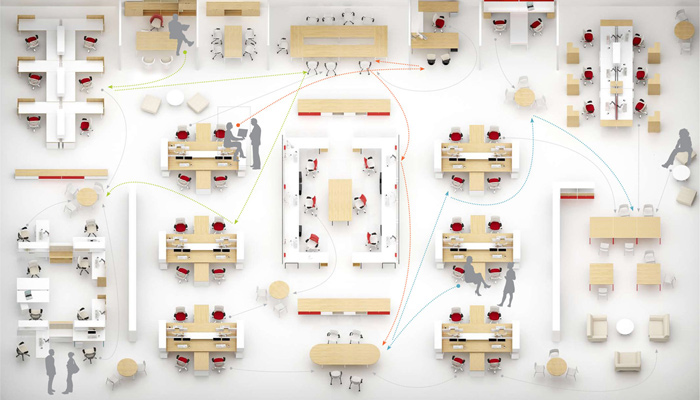
The Changing Workplace
Work that used to occur within the individual workspace now happens throughout the entire workplace
The way the primary workspace is used has changed in the past 10 years – driven by wireless technology, highly mobile work styles, and the shift to more informal and formal collaboration.
In response, organizations are creating primary workspaces with greater openness than in the past to support the easy transition between individual and group work modes. In addition, new types of agile, casual meeting spaces are being embraced.
Antenna supports this evolution
Through its strong horizontal nature (tables rather than panels), Antenna supports these trends with an emphasis on connecting people, not dividing them. Antenna’s scope of freestanding tables, desks and storage components can be used to create the wider variety of settings now required to support individual and group work modes. Antenna provides boundaries and visual screening, to balance privacy and interaction.
Unlike traditional panel-based systems (in which high panels can provide a false sense of acoustic privacy and may not reduce interruptions), Antenna uses deskmounted screens, storage, and changes in materials to demarcate boundaries, and manage visual access into the personal workspace. These features send a signal to others about availability for interaction and, thus, reduce distractions and interruptions.
How To Plan with Antenna Workspaces
1. Use Antenna elements to create and differentiate work zones
Antenna provides a variety of storage elements for both personal and enterprise storage needs, including deskmounted and freestanding storage to define space and help zone work activity areas. Together, these elements can be planned to provide co-workers with the visual cues that distinguish individual and group workspace boundaries.
2. To provide visual privacy within the primary workspace, create opportunities for “strategic visual screening” using Antenna elements
High panels and monolithic enclosure do not necessarily make for better visual or acoustic privacy. A lower horizon can be equally effective. Antenna desk-mounted and floorstanding storage, displays on Sapper monitor arms, and 49” high screens create opportunities for “strategic visual screening” around the workspace. These carefully positioned elements permit employees to see out (or be seen) by simply shifting their posture.
3. Lower horizons and selectively deployed screening elements can reduce noise and interruptions
How? Reduced enclosure provides a better overall view of fellow employees and their work activities. Visibility can actually reduce noise and distractions because it provides social feedback to others, giving them a better sense of when to moderate noise and conversations, and when to approach each other.
4. Well-defined workspace boundaries encourage respectful collaboration
In the primary workspace, use color and material changes to differentiate between individual territory and potential shared areas. Antenna desks link in clusters and combine with screens and storage to define individual areas for heads down work. This makes it easy for employees to know where it is appropriate to approach each other at the workstation. Desk and table extensions add a collaborative element to individual spaces for quick sharing of information.
5. Leverage Antenna elements in adjacent enclosed spaces to support privacy during casual interaction
Sometimes focus or shared work requires greater acoustic privacy than the primary workspace can provide. In this case, plan for “third spaces,” casual meeting spaces (breakout rooms, huddle spaces, etc.) furnished with Antenna elements. Focus spaces are designed to provide greater acoustic privacy for individual work or conversations between two people. Simple Antenna tables are adequate in smaller rooms for one-on-one meetings or private phone calls. And the same desk elements, coupled with freestanding and wall-mounted storage, create private offices that also work as meeting rooms.
DOWNLOAD "WHAT TO CONSIDER WHEN PLANNING WITH ANTENNA WORKSPACES" TO READ THE FULL PAPER



















